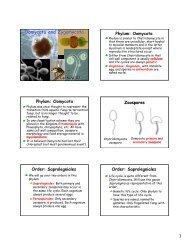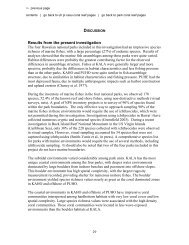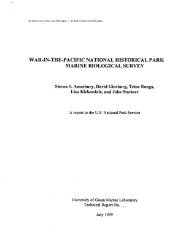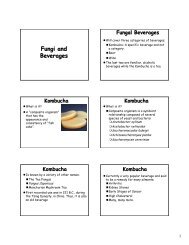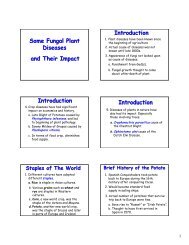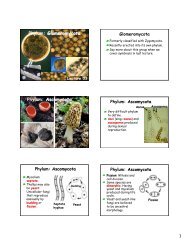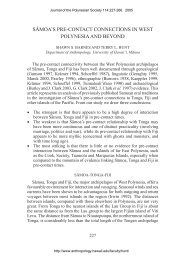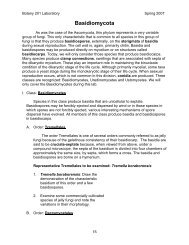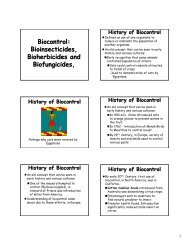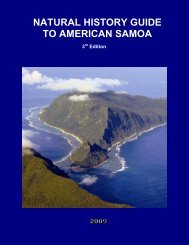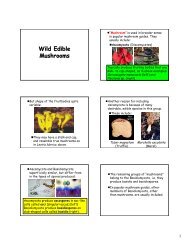american samoa - University of Hawaii at Manoa Botany Department
american samoa - University of Hawaii at Manoa Botany Department
american samoa - University of Hawaii at Manoa Botany Department
- No tags were found...
You also want an ePaper? Increase the reach of your titles
YUMPU automatically turns print PDFs into web optimized ePapers that Google loves.
California grass (Brachiaria mutica). Only fau (beach hibiscus) and Fimbristylis cymosa aren<strong>at</strong>ive plants.Between Unnamed Stream/Vaipito Stream Confluence and Route 1Between the unnamed stream/Vaipito Stream confluence and Route 1, the Vaipito Streamchannel became narrower. The stream bank typically was lined with a basaltic rock or concretewall. California grass was dominant immedi<strong>at</strong>ely upland <strong>of</strong> the stream channel margin. Lesseramounts <strong>of</strong> Sorghum sudanense, fue saina (mile-a-minute vine), beggar’s tick, taamu (gianttaro), sanasana (Job’s tears), and bananas were also evident along this stream segment.Upstream <strong>of</strong> Route 1Upstream <strong>of</strong> Route 1, the Vaipito Stream becameincreasingly channelized. Stream banks representeda combin<strong>at</strong>ion <strong>of</strong> basaltic rock walls, concrete walls,rock-filled gabion baskets, and exposed dirtembankments. These characteristics left a narrowzone for the growth <strong>of</strong> veget<strong>at</strong>ion.Job’s tears, California grass, taamu (giant taro) andmile-a-minute vine were prevalent along streamsegments th<strong>at</strong> were characterized by dirtembankments. Various trees were also sc<strong>at</strong>teredalong the stream banks. These trees primarilyincluded ulu (breadfruit), vavae (kapok), beachhibiscus, falaga (Barringtonia samoensis), pulu(banyan), lau p<strong>at</strong>a (Macaranga harveyana), mango,coconut, and banana.Veget<strong>at</strong>ion TrendsLower Vaipito Stream was once characterized by a healthy mangrove swamp. However, theswamp was filled by the U.S Navy in the early 1960’s to support past naval activities.Subsequently, the use <strong>of</strong> the landfill area was converted to its present day recre<strong>at</strong>ional use withthe establishment <strong>of</strong> Pago Park.In 1996, significant restor<strong>at</strong>ion efforts were made by the American Samoa EnvironmentalProtection Agency and the American Samoa Community College, Land Grant Program alongselected portions <strong>of</strong> lower Vaipito Stream.Following initial coordin<strong>at</strong>ion with the pulenuu and village council <strong>of</strong> Pago Pago Village,ASEPA and ASCC Land Grant program personnel planted 127 trees just upstream <strong>of</strong> theVaipito Stream mouth on September 28, 1996. These trees were planted along the east side <strong>of</strong>the stream.In mid-October and early November <strong>of</strong> 1996, an additional 1,000 feet <strong>of</strong> stream bank wasplanted upstream <strong>of</strong> Vaipito Stream’s unnamed lower confluence. Most <strong>of</strong> 238 trees plantedwere seedlings th<strong>at</strong> were propag<strong>at</strong>ed <strong>at</strong> ASCC Land Grant facilities during the summer <strong>of</strong> 1995.One exception was fau trees th<strong>at</strong> represented 2.5-foot long cuttings. All <strong>of</strong> the trees wereplanted and spaced <strong>at</strong> six-foot intervals. Falaga (Barringtonia samoensis) was planted alongAmerican Samoa Wetland/Stream Restor<strong>at</strong>ion and Enhancement PlanFebruary 2001, Vaipito Stream, Page 6-6



